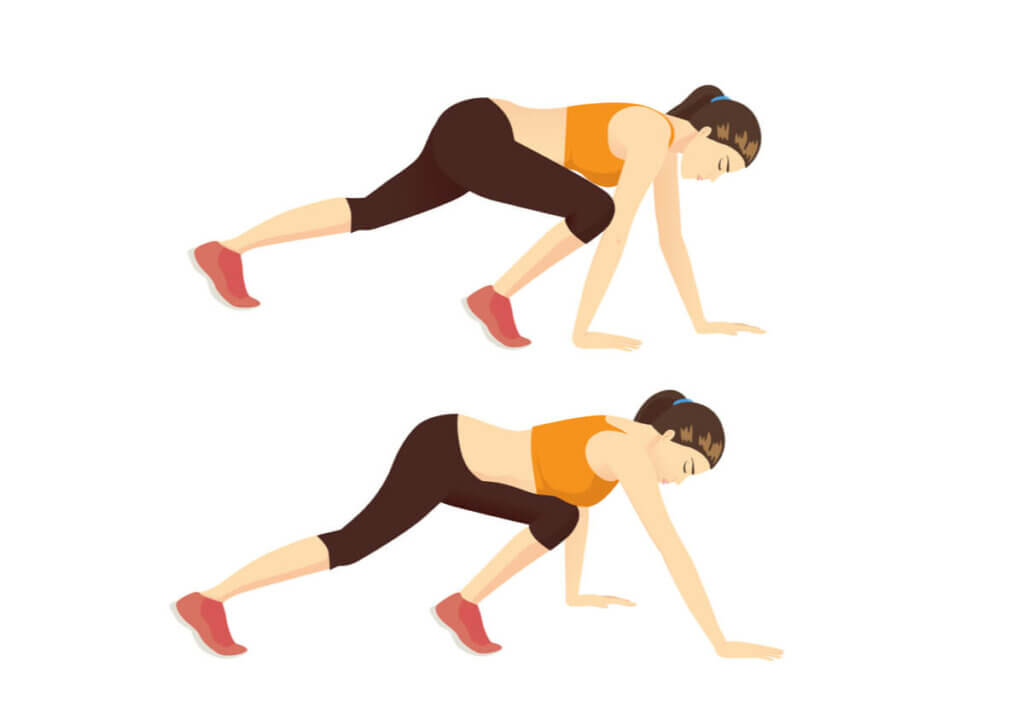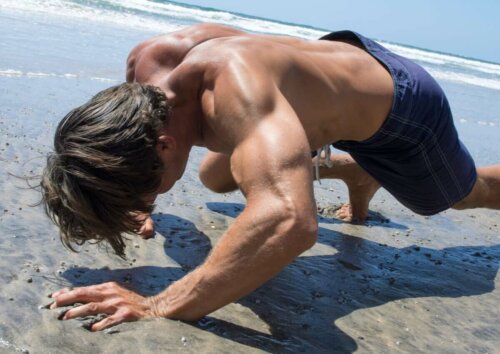Bear Crawls: What are the Benefits?

The world of sports training is swamped with movements and exercises suitable for everyone. Among these, copies of specific sports gestures or animal movements stand out. An example of the latter would be bear crawls; a specific name for an unusual exercise.
When it comes to talking about training routines for toning, strengthening, or working the muscles, people don’t commonly include bear crawls. However, this exercise provides a series of benefits for the body. So, what are they?
What are bear crawls?
Generally speaking, this is an exercise that copies how bears walk. The exercise requires you to mimic how a bear moves in a predetermined space as part of your exercise routine. It allows you to stimulate different muscle groups at the same time.
To do it, you have to start on all fours – the palms of your hands and feet. Also, make sure that your torso stays straight and parallel to the ground. We also advise that you bend your knees slightly.
Lastly, but no less importantly, when it comes to the positions of your hands, you should keep them a little further apart than your shoulders. This way, you’ll find you have better balance as you do them.
Once you have assumed the beginning position, you should do the exercise moving one arm and one leg at a time. You can choose which side you start with, the important thing here is that you continue with good coordination as you do it.

The benefits of bear crawls
You could say that stimulating diverse muscle groups at the same time is a benefit in itself. However, bear crawls still present other positive aspects that are worth mentioning.
No spacial limit
One of the biggest benefits of bear crawls is that they don’t require a huge space. In fact, it’s enough to move a few chairs around to use that space. Similarly, spaces such as parks, small lanes, or green areas can be enough to get started.
No extra materials
Beyond comfy clothing, you won’t need any extra material to do bear crawls. Your body, extremities, and determination to make it through are all that you need to include this exercise in your daily training routine.
Muscular development
The technical aspect of this exercise allows you to stimulate large groups of muscles. Interestingly, you use practically all of the main muscles when you do it.
For example, in the arms, you’ll use the brachial triceps and deltoids the most; in the torso, you place more demand on the trapezius muscle, latissimus dorsi, rectus abdominals, and the obliques; and, finally, in the legs and hips, you’ll work the glutes, buttocks, pelvis, gastrocnemius, and quadriceps the most.
Coordination improvement
In addition to strength and resistance, bear crawls require a high level of coordination. Although we advise you to have a basic level of fitness before starting this exercise, you shouldn’t feel frustrated or avoid practicing it if you feel you’re not coordinated enough!
The only thing you need is regular practice, discipline, and a desire to learn how to do it. Remember that gradually you’ll develop better coordination.

Different intensities
The intensity of the exercise largely depends on your physical ability and desired results. With that in mind, remember to follow through with your plans, and, if you’re just starting out, increase the intensity progressively. This way you reduce the probability of hurting yourself and you’ll develop properly.
Bear crawls, have you heard of them?
It’s likely that you haven’t heard about this exercise before today, and as a result, you may not be sure how to do it. If that’s the case, we recommend you seek advice. This won’t just help you to learn how to properly do this technique, but also how you can include them in your regular routine.
With professional help, you can include bear crawls in your exercise routine to work towards your goals. Finally, remember to complement your training with good life habits regarding diet and rest, and you’ll quickly see the results!
The world of sports training is swamped with movements and exercises suitable for everyone. Among these, copies of specific sports gestures or animal movements stand out. An example of the latter would be bear crawls; a specific name for an unusual exercise.
When it comes to talking about training routines for toning, strengthening, or working the muscles, people don’t commonly include bear crawls. However, this exercise provides a series of benefits for the body. So, what are they?
What are bear crawls?
Generally speaking, this is an exercise that copies how bears walk. The exercise requires you to mimic how a bear moves in a predetermined space as part of your exercise routine. It allows you to stimulate different muscle groups at the same time.
To do it, you have to start on all fours – the palms of your hands and feet. Also, make sure that your torso stays straight and parallel to the ground. We also advise that you bend your knees slightly.
Lastly, but no less importantly, when it comes to the positions of your hands, you should keep them a little further apart than your shoulders. This way, you’ll find you have better balance as you do them.
Once you have assumed the beginning position, you should do the exercise moving one arm and one leg at a time. You can choose which side you start with, the important thing here is that you continue with good coordination as you do it.

The benefits of bear crawls
You could say that stimulating diverse muscle groups at the same time is a benefit in itself. However, bear crawls still present other positive aspects that are worth mentioning.
No spacial limit
One of the biggest benefits of bear crawls is that they don’t require a huge space. In fact, it’s enough to move a few chairs around to use that space. Similarly, spaces such as parks, small lanes, or green areas can be enough to get started.
No extra materials
Beyond comfy clothing, you won’t need any extra material to do bear crawls. Your body, extremities, and determination to make it through are all that you need to include this exercise in your daily training routine.
Muscular development
The technical aspect of this exercise allows you to stimulate large groups of muscles. Interestingly, you use practically all of the main muscles when you do it.
For example, in the arms, you’ll use the brachial triceps and deltoids the most; in the torso, you place more demand on the trapezius muscle, latissimus dorsi, rectus abdominals, and the obliques; and, finally, in the legs and hips, you’ll work the glutes, buttocks, pelvis, gastrocnemius, and quadriceps the most.
Coordination improvement
In addition to strength and resistance, bear crawls require a high level of coordination. Although we advise you to have a basic level of fitness before starting this exercise, you shouldn’t feel frustrated or avoid practicing it if you feel you’re not coordinated enough!
The only thing you need is regular practice, discipline, and a desire to learn how to do it. Remember that gradually you’ll develop better coordination.

Different intensities
The intensity of the exercise largely depends on your physical ability and desired results. With that in mind, remember to follow through with your plans, and, if you’re just starting out, increase the intensity progressively. This way you reduce the probability of hurting yourself and you’ll develop properly.
Bear crawls, have you heard of them?
It’s likely that you haven’t heard about this exercise before today, and as a result, you may not be sure how to do it. If that’s the case, we recommend you seek advice. This won’t just help you to learn how to properly do this technique, but also how you can include them in your regular routine.
With professional help, you can include bear crawls in your exercise routine to work towards your goals. Finally, remember to complement your training with good life habits regarding diet and rest, and you’ll quickly see the results!
All cited sources were thoroughly reviewed by our team to ensure their quality, reliability, currency, and validity. The bibliography of this article was considered reliable and of academic or scientific accuracy.
- de la Cámara, M. Á., Jiménez-Fuente, A., & Pardos-Sevilla, A. I. (2020). Ejercicio funcional en salud: características y base metodológica para su aplicación. Rehabilitación. https://doi.org/10.1016/j.rh.2019.12.003
This text is provided for informational purposes only and does not replace consultation with a professional. If in doubt, consult your specialist.








